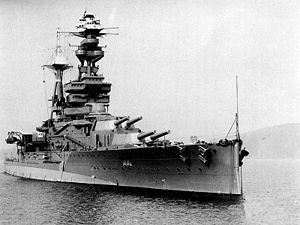The HMS Royal Oak was one of five of the Royal Sovereign class battleships built at the HM Dockyard in Devonport laid down in January 1911 and launched in November, 1914.
After being completed in May, 1916, the HMS Royal was first deployed in WWI within the Fourth Battle Squadron and was active in the Battle of Jutland. She had previously been a coal-burning vessel and had over 75 tanks for fuel. The battleship weighed 29150 tons, and was 174 m long with a beam of 28 m.
After the first world war, the HMS Royal Oak was used during planning exercises and diplomatic duties. In 1918, she collided with HMS Campania, and became well recognized during a disagreement in 1928 between senior officers, which became known as the Royal Oak Affair. She also had a number of upgrades during this time including the additions of anti-aircraft armour, an aircraft catapult, and improvements to her directional radio and fire control equipment. These upgrades resulted in the ship’s decreased speed and heavier weight.
In October 1939, the HMS Royal Oak was anchored at the Scapa Flow’s northeastern corner in order to provide protection to the nearby Netherbutton radar station when, in the early morning hours of October 14, she was a victim of a torpedo attack and sank.
The torpedoes were fired by U-47, one of three U-boat submarines, which was commanded by German Captain Gunter Prien, at 1:04 and 1:16am. The HMS Royal Oak was the only ship in Scapa Flow at the time and it’s sinking caused the loss of a total of 834 officers out of a possible 1146.
This tragedy resulted in the deliberate sinking of other blockships, and allowed for the discovery that the Germans had accessed the Flow through Kirk Sound. This ultimately prompted the building of the Churchill Barriers in order to permanently block access to the eastern sounds, the Canmore reports.
Today, a buoy marks the placement of the sunken ship at 3 Km SSW of the Scapa Pier and is officially designated as a protected war grave under the Protection of Military Remains Act. Every year, a white ensign is replaced on the staff flagpole.
